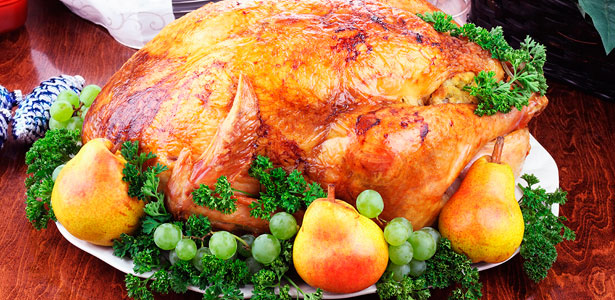Debunking The Myth

Is your Thanksgiving turkey making you drowsy?
BY: LESLIE RESCHLY BSN,RN
One of my most memorable Thanksgiving meals occurred when we ventured with family to a restaurant in Charleston for a complete buffet of every traditional holiday dish you could imagine to eat! This was followed by a lazy nap (in the hotel), a holiday tradition for the men in my family as I grew up but never for the women as we were in charge of clean up. There was even a rival football game playing on the TV to hide the fact that the men were really sleeping. Of course, they blamed it on the turkey! Poor Tom Turkey getting a bad rap again! Is the reputed narcoleptic state induced by eating turkey a fact or fiction? Is the myth of L-tryptophan scientifically based or hear say? And, what is L- tryptophan anyway?
L-tryptophan is an essential amino acid. Amino acids are the building blocks of proteins that are necessary in our body. An essential amino acid means it must be supplied by the foods we eat as it cannot be made by our body. Tryptophan is found in many protein sources including turkey, chicken, beef, pork, cheese, yogurt, fish and eggs. In fact, turkey is not any higher in tryptophan than other poultry. One dietary source I found in my research reported an average serving of chicken or ground beef contained the same levels of tryptophan as turkey. The same source stated that Swiss cheese and pork have higher levels. Can you really blame your slumber on turkey but not on a gigantic burger?
Tryptophan is converted in our body to niacin (a B vitamin) and serotonin. As you may recall from some of my previous articles, serotonin is a neurotransmitter in the brain that is associated with mood. Higher levels of serotonin make you feel better. Serotonin is also metabolized in the pineal gland to the hormone melatonin which helps to control sleep and wake cycles. (Do you feel like you need your organic chemistry and physiology notes from college yet?)
So, just reading this, you might assume that all that turkey makes tons of melatonin and you fall asleep. Well, not really. Although dietary supplements range from 500mg-1000mg, a serving of turkey only has 350mg of tryptophan. You would need to devour the whole bird, on an empty stomach and with no other proteins to blame it on your need for a nap! That is unlikely at any holiday table!
What really occurs has to do with the whole Thanksgiving meal itself. First, this time of relaxation with family (I know…think Norman Rockwell) allows the restful state. Second, there typically is alcohol involved which contributes to nap status. Also, we gorge ourselves causing blood to divert to the intestinal tract which requires energy. However, the typical Thanksgiving meal also is heavy on carbohydrates and this is the real culprit. When you eat carbohydrates (sugars) like potatoes, candied yams etc. the pancreas secretes insulin to “handle” the sugar load. Insulin stimulates muscles to absorb some types of amino acids but tryptophan is left in the blood and crosses into the brain where serotonin is formed then processed into melatonin. Thus, carbs make you sleepy!!
Chemistry and physiology lesson aside, Tom Turkey deserves an apology! Turkey alone is not responsible for your nap. However, I’m really hoping my children won’t read this article so I can blame the turkey and they can clean up…good idea?
Wishing you a blessed and restful Thanksgiving!
HERE ARE SOME TURKEY FUN FACTS:
- The wild turkey was hunted nearly to extinction by the early 1900s; the population reached a low of around 30,000 birds. Thanks to restoration programs across North America the numbers have climbed above seven million today.
- There are six subspecies of wild turkey, all native to North America. The pilgrims hunted and served the eastern wild turkey on their Thanksgiving table, sometimes called the forest turkey, they are the most numerous of all the turkey subspecies.
- Male turkeys are called “gobblers,” after the “gobble” call they make to announce themselves to females (which are called “hens”) and compete with other males. Other turkey sounds include “purrs,” “yelps” and “kee-kees.”
- An adult gobbler weighs 16 to 22 pounds on average, has a beard of modified feathers on his breast that reaches seven inches or more long, and has sharp spurs on his legs for fighting.
- A hen is smaller, weighing around 8 to 12 pounds, and has no beard or spurs. Both genders have a snood (a dangly appendage on the face), wattle (the red dangly bit under the chin) and only a few feathers on her head.
- Studies have shown that snood length is associated with male turkey health. Female turkeys prefer males with long snoods and that snood length can also be used to predict the winner of a competition between two males. (I guess size matters to turkeys?)
- Turkeys can run at speeds of up to 25 miles per hour and fly as fast as 55 miles per hour.
- When a hen is ready to make little turkeys, she’ll lay about 10 to 12 eggs, one egg per day, over a period of about two weeks. The eggs will incubate for about 28 days before hatching.
- Baby turkeys, called poults, eat berries, seeds and insects, while adults have a more varied diet that can include acorns and even small reptiles.
- Benjamin Franklin never proposed the turkey as a symbol for America, but he did once praise it as being “a much more respectable bird” than the bald eagle. (What?!)











Leave a Reply